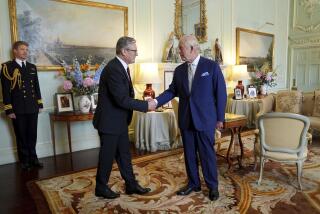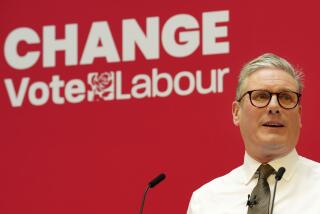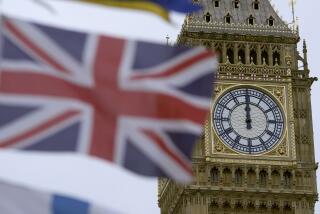Polls and By-Elections Damaging, but . . . : Reverses for Thatcher Give Foes a Ray of Hope
LONDON â To the traditional measures of inevitability, death and taxes, a third has in recent times been axiomatic in Britain: another election victory for Prime Minister Margaret Thatcher and her Conservative Party.
Now about halfway through a third term, Thatcher has been regarded by most political analysts as a shoo-in for a fourth. But in the last week or so, she has suffered a series of reverses that some of her political rivals claim give them a ray of hope--although the Tories profess not be worried and are quick to explain why.
Thatcherâs recent reverses began with poor showings in two by-elections to fill vacancies in Parliament. In one, the Conservative candidate finished a distant third; in the other, the Conservative won but only by an eyelash in a constituency that had been considered safe.
Then, last weekend, two public opinion polls showed the Labor Party running neck-and-neck with the Conservatives, or even slightly ahead. It was Laborâs strongest showing in more than two years, wiping out a 10% gap that had existed only weeks earlier.
The polls showed that a key factor in the swing is disillusionment with government economic policy, which has boosted interest rates to their highest level in eight years--13% on mortgages, for example.
On Wednesday there was more bad economic news as Britain reported a higher-than-expected trade deficit for January. The figures suggested that interest rates are still not high enough to dampen consumer spending, and a six-column, page one headline in Thursdayâs Independent newspaper suggested what the political implications might be. âTrade Gap Puts Lawson on Trial,â it said, referring to Nigel Lawson, chancellor of the exchequer.
Midterm Patch
Yet a senior Thatcher aide told an interviewer: âI donât think you should worry too much about this (the reverses). Itâs a typical mid-term patch.â
To be no worse than even is really a victory at this stage, the aide said, and added, âWe always thought 1989 would be sticky and difficult.â
Many independent analysts agree, pointing to even worse mid-term slumps in Thatcherâs two previous governments.
âThis is nothing,â Robert M. Worcester, director of Market & Opinion Research International (MORI), said of the poll results. âThis is a slight cold, whereas before they had pneumonia and still recovered.â
The polls showing Labor narrowing the gap were conducted by the Harris and Gallup organizations. The results of the next MORI poll are to be published this weekend in the Sunday Times of London.
Perhaps Thatcherâs greatest strength is the disarray among her rivals, what Peter Jenkins, a columnist for the Independent, referred to this week as âthis crisis of opposition.â
Despite its improved showing in the polls, Labor is still considered by many to be unelectable because of the nature of its support and because of Britainâs electoral system. The party has overwhelming backing in many constituencies but seems to be unable to mount a real challenge in the more populous southeast of the country, where Thatcher dominates.
Meanwhile, two center parties, the Social Democratic Party headed by David Owen and the Social and Liberal Democrats, headed by Paddy Ashdown, effectively cancel each other out.
In last weekâs Richmond by-election, a Conservative won with only 37% of the vote, while the two centrist parties split 54%.
In the general elections of 1987, the Conservatives won 375 of the 650 seats in Parliament with only 42% of the vote. Labor finished second with 30% of the vote but only 229 seats.
âIf the Tory share isnât below 42% or 43%, then everybody else is whistling in the dark,â Worcester said.
Ashdown has been pushing for a merger of the two centrist parties in hopes of mounting an effective challenge to Thatcher. But Owen notes that this approach failed miserably in 1987.
âCapricious, Whimsicalâ
Owen advocates a âconstitutional coalitionâ in which the two centrist parties and Labor would form an electoral pact to mount a unified, constituency-by-constituency attack. But Labor leader Neil Kinnock has rejected the idea. He says Owen is âso capricious, so whimsical, so egotistical (that) what he says this week might be entirely different next week.â
That apparently leaves a revitalized Labor Party as the only potential hope for defeating Thatcher. Kinnock, whom some were writing off as party leader as recently as last fall, has been more adept lately at capitalizing on Conservative weaknesses. His revamped shadow cabinet has hit hard and apparently effectively at such controversial government programs as reform of the National Health Service and privatization of the utilities.
Kinnock has sharpened his polemics, keeping his parliamentary challenges shorter and more to the point than previously, and injecting a touch of humor. A source who saw the Labor leader at a party the other night said, âHeâs really feeling extremely bullish.â
At this early stage, only the most foolhardy would suggest that it is time to begin writing Thatcherâs political obituary. Analysts say they will be watching three upcoming tests before even acknowledging that the opposition might have a chance of ending her domination.
The first will be another by-election, at the Vale of Glamorgan in Wales, and it is expected to be hard fought between Labor and the Conservatives.
Next come elections to local government councils--long a stronghold for Labor candidates. And finally there are elections for the European Parliament in June.
Given the importance of momentum, one analyst noted, the Conservatives could be vulnerable if Labor makes a series of stronger-than-expected showings.
âThen her people could get panicky, start running around and put their foot in it,â the analyst said.
More to Read
Sign up for Essential California
The most important California stories and recommendations in your inbox every morning.
You may occasionally receive promotional content from the Los Angeles Times.










